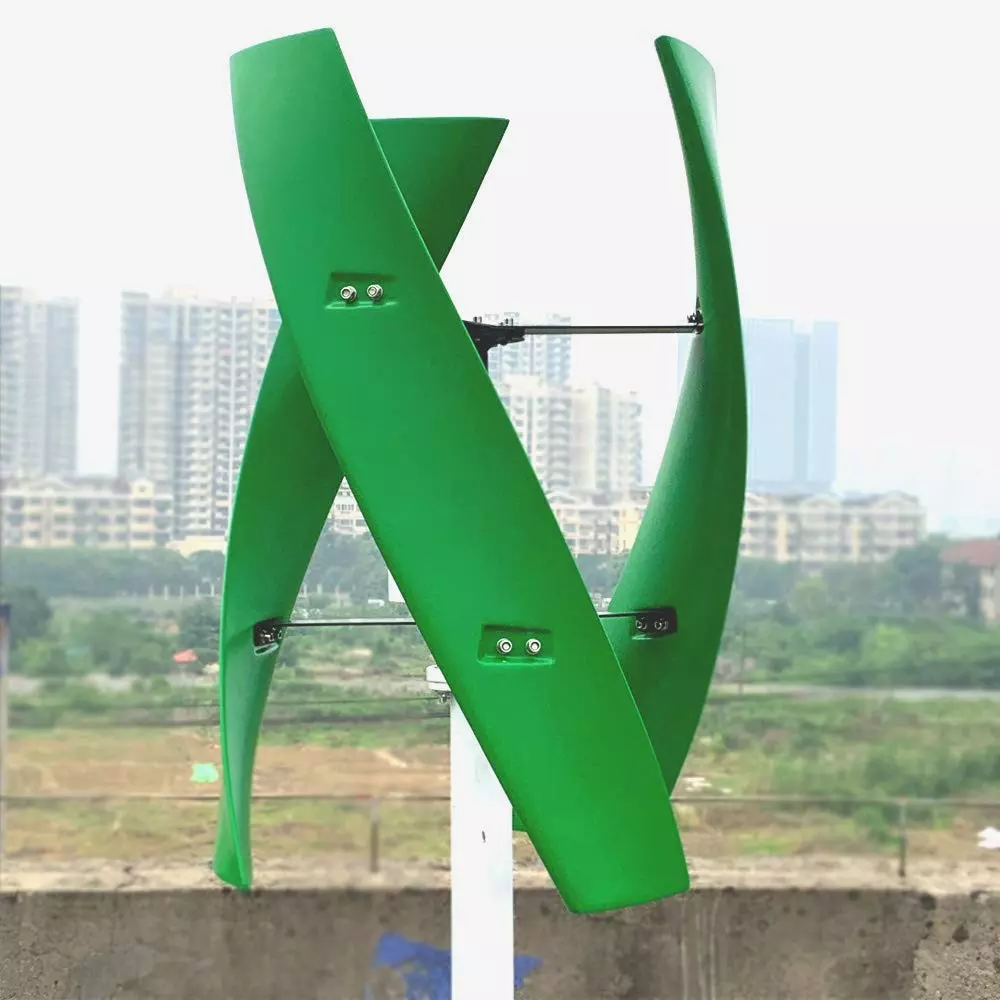Tinkering in his backyard, Dan Marsh aims to devise an efficient source of electricity for suburban rooftops and beachside barbecues.
On arriving at Dan Marsh’s home in the King William Historic District of San Antonio, the first thing you notice is the oddly modified truck in the driveway. A custom wooden platform sits on the front of his 2013 Ford F-150, where Marsh can bolt various small wind turbines—miniature windmills that generate electricity—to take for a “spin” on the Interstate 35 and 410 frontage roads. 400 Watt Wind Turbine

With help from his wife and a teenage neighbor with a beginner’s interest in engineering, Marsh has performed several such test runs, logging the voltage generated by each turbine while highway-speed winds turn the blades. The 64-year-old retired HVAC professional and amateur inventor is out to prove he has solved a key problem in scaling down wind power generation to the consumer level—small enough to someday efficiently power a home from a rooftop or a backyard.
Based on these highly unofficial field tests of the prototype he’s been building on his back porch and commercial models available on Amazon, as well as lab tests arranged through the EPIcenter Energy Incubator and Accelerator in San Antonio, Marsh claims that his proprietary-technology Pirate Wind Turbines will someday produce 30 percent more power at 40 percent lower cost than currently available models, while drastically reducing noise and vibration to boot. His biggest roadblock, he says, is funding more long-term testing and prototype-building. He is seeking investors.
“The military loved my bracket on the front of the truck,” says Marsh, who has met with representatives of the U.S. Air Force through a mentorship program at Texas State University. “They said, ‘That right there tells me who you are, that you’re not going to wait for money, you’re not going to wait for anything, you’ve got an idea and dammit, you’re gonna get it tested.’ ”
Indeed, the goateed, gregarious Marsh is about the furthest thing imaginable from an ivory-tower research scientist. He’s a lifelong tradesman who spent 23 years servicing commercial heat, ventilation, and air conditioning systems on hot Texas rooftops before moving up in the industry to become a project manager, overseeing the installation of HVAC at high-tech factories for companies such as Intel, Micron Technology, and Motorola.
His gearhead tendencies date back to the fourth grade, growing up in Austin, when his father suggested that he try taking apart and reassembling the family lawnmower. Soon Marsh was hooked on working on anything with wheels. He built BMX-style bikes and, eventually, modified motorcycles, cars, and trucks. While enrolled in an HVAC program at Texas State Technical Institute in Waco, Marsh took up street racing for pocket money. His vehicle was a souped-up 1972 Toyota Hilux—a boxy truck, not your typical racing machine.
“My truck was so badass, you could actually feel the ground shaking,” he says. “I’d have people in Corvettes and Camaros and Trans-Ams opening their windows, looking around trying to figure out where the noise was coming from. Then I’d look over, and there’s a special nod, you know, we’d point to the light: ‘Mm-hmm.’ ‘Yeah.’ And then when the light turned green . . . Those were the good old days.”
As Marsh grew older, his tinkering shifted from speedy vehicles to renewable energy. At a previous home in Canyon Lake, featured on a 2009 episode of Discovery Channel’s Renovation Nation for its custom-built green technologies, he was an early adopter of home solar power and geothermal heat pumps. Marsh also tried mounting a wind turbine on that house, hoping to run his pool pump with the energy he generated, but he had to remove it because of excessive noise and vibration.
“Even though the instructions said, ‘Don’t bolt this to the house because of vibration,’ I was like, ‘Well, how bad can it be?’ ” Marsh says. “And it was horrible. It vibrated all the two-by-fours in the house.”
Small wind turbine technology, he learned, has long been limited by the problem of excess voltage generation in high winds. If too much voltage reaches the charge controller box, it can melt expensive components and even cause a fire. It can be hard to avoid a meltdown during storms and other high-wind events. Traditionally, the two ways to stop a wind turbine from generating excess voltage are to design the blades to furl—that is, to turn away from high winds—which leads to noisy vibrations, or to apply some sort of physical or electronic brake. E-brakes, however, can be quite expensive, costing nearly as much as the rest of the turbine combined.
Marsh believes he has found a way out of this dilemma with a patent-pending “secret sauce” he declines to discuss in detail, which he says can limit the amount of voltage generated so that it never exceeds what a charge controller can handle, even as high winds spin the turbine blades rapidly. Marsh has driven his truck-mounted turbines at up to 75 miles per hour, a speed that should be more than double what’s needed to damage a charge controller unprotected by an e-brake—but, he claims, his components did not catch fire or melt, thanks to his proprietary technology.
Because Marsh’s technology is so new, few engineers have gotten a chance to independently assess its potential. Mark McHenry, marketing manager of Morningstar Corporation, a leading producer of charge controllers, who has talked to Marsh about his plans and experiments, says, “I don’t have his turbine in my lab, but what he’s trying to do, sure, that sounds very good. That’s important, no question about it.” McHenry affirms that Morningstar controllers, like all others on the market, tend to melt down if fed too much voltage.
One industry figure who has observed a bit more of Marsh’s testing is Hauke Roeschmann, an MIT-trained engineer with a background at Dell and in management consulting. Roeschmann is an entrepreneur-in-residence at Texas State and serves as an advisor to winners of the university’s New Ventures pitch competition. As such, he has been working with Marsh on Pirate Wind Turbines for much of the past year, introducing him to contacts in government and industry and helping arrange a student-led long-term test of Marsh’s turbines on the roof of the campus engineering building this fall. “What the early tests seem to prove needs to be borne out long term and in a larger test, but so far, so good,” Roeschmann says of Marsh’s turbines. “He’s a crafty little guy.”
Roeschmann suggests the military might be interested in small turbines as a way to provide power to remote clandestine positions. “What if you were to drop into, let’s say, a remote observation spot where you can’t have a large solar array, because it might give you away?” Roeschmann says. “A wind turbine has a very, very small visual footprint from above. It might make sense to do that instead.”
Marsh, for his part, thinks his earliest customers might be beachgoers looking for a bit of electricity to power their good times in a high-wind environment. “My wife said, ‘Can this run a blender? So we can have a margarita on the beach?’ ” he says. “I’m like, ‘Yes!’ ” His homemade one-thousand-watt turbine prototype—an eight-by-eight-by-sixteen-inch aluminum box—loads easily in a car trunk or truck bed. Of course, you’d also have to haul and set up a blade assembly to attach the unit to—a long pole holding the fan blades—to enjoy that margarita. (The version Marsh has tested requires digging a small hole nearly three feet down into the sand, into which he plants a pole that extends more than 10 feet high with a fan between 4 and 6 feet in diameter at the top.) His three-thousand-watt prototype, on the other hand, is more than five times the size and much more difficult for a single person to lift.
Many of the other uses that Marsh imagines for his turbines are archetypically Texan—powering truck-mounted lights for night fishermen along the Gulf Coast, providing entertainment for football tailgaters, and even resurrecting abandoned well pumps in rural areas of the state. “Because my generator is self-regulating, I eventually could use the old-style fans that are up there and tie it into my generator and have it run a pump,” Marsh says of the classic Aermotor windmills that have fallen into disuse on many Texas ranches. “And it’d still look like it was old, except for the white or aluminum generator container up there.”
Of course, the largest potential market for small turbines is wind power generation that could be tied into the grid—setting up turbines on your roof or in your yard to reduce your electricity bill. The National Renewable Energy Laboratory estimated last year that the United States could profitably build 1,400 gigawatts of capacity from small wind turbines, which is equal to more than half of the country’s annual electricity consumption.
To power everything in your home (at least when the wind is blowing), you’d need more like five thousand watts, more than what any of Marsh’s existing prototypes can generate. He says it’s certainly feasible for him to eventually scale up to that size, but he estimates that the current return on investment for home wind generation is between ten and fifteen years. Plus, it still requires putting up with a lot of noise and vibration during high-wind events. (And the more wattage you hope to generate, the taller and larger your blade assembly typically needs to be.) He says that his Pirate Wind Turbines will be significantly more economical, but he’s not ready to make any specific predictions about how long it will take to recoup one’s investment via home energy savings.
Marsh’s target consumer price for a USA-built one-thousand-watt turbine is $1,800. He notes that a Chinese-made, one-thousand-watt turbine currently costs $1,300 on Amazon. But he argues that his price point is still a better bargain because many purchasers of the existing technology will eventually realize that they also have to buy an electronic brake for $800 to $1,000 extra.
Even if only the sorts of customers he refers to as ”preppers” adopt his wind turbines for home electricity generation, Marsh still sees intrinsic value in moving the technology forward. “I’m doing what I’m doing because I want something that works, and I want it to be quiet, and I don’t want the vibration,” he says. “The industry is just filled with junk, so I’m doing something about it.”
What really makes Marsh’s eyes light up is not, in the end, the idea of making millions of dollars or dotting the beaches of Padre Island with his machines. Instead, Marsh gets most visibly excited when discussing his next idea for a turbine-testing setup—a purchase he hopes will someday replace his modified truck.
“My simple wind tunnel idea—I’ve already looked into it—is to buy an air-fan boat, like you see in the swamps of the Mississippi, with the big engine and propeller,” he says, smiling broadly. “I’d like to own one of those swamp boats, just so I could hit my turbine with a one-hundred-mile-an-hour wind. I would love to build a homemade wind tunnel out of an old swamp buggy.”
Russell Gold is a senior editor at Texas Monthly. He writes about energy and business.
Doyin Oyeniyi writes about culture and checks facts.
Tom Foster writes about business, innovation, and creative people.
Daniel Vaughn is the country’s first barbecue editor, and he has eaten more barbecue than you have.
Skip Hollandsworth specializes in long-form narratives.
Kathy Blackwell is an executive editor at Texas Monthly. She oversees the magazine’s travel and style sections.
Mimi Swartz is a staff writer based in Houston.

Household Wind Generators We report on vital issues from politics to education and are the indispensable authority on the Texas scene, covering everything from music to cultural events with insightful recommendations.